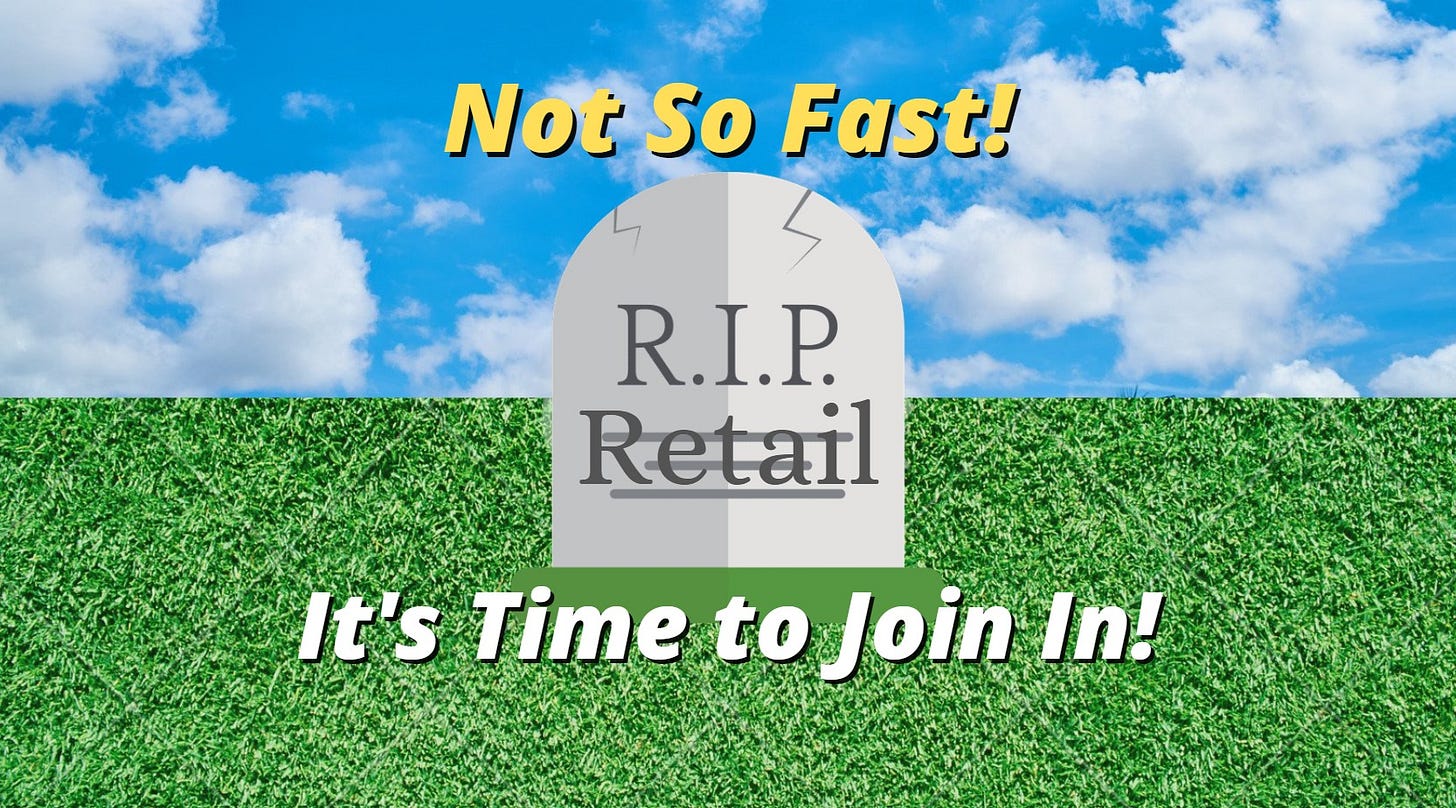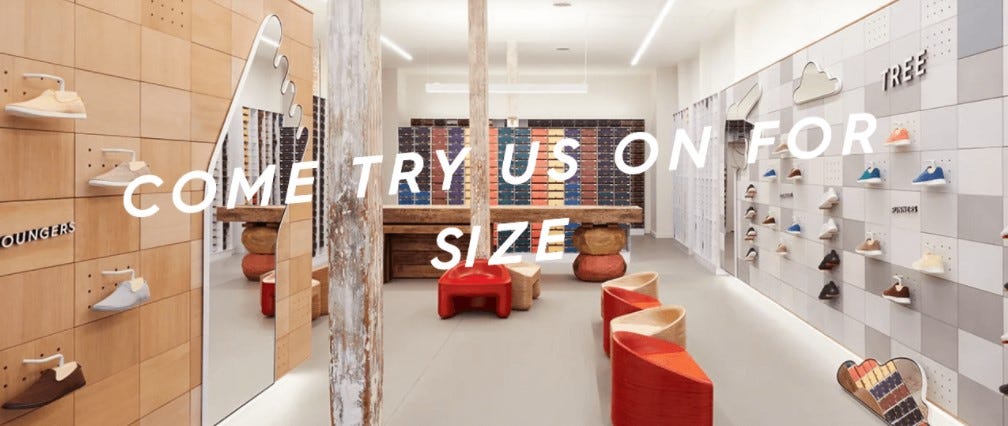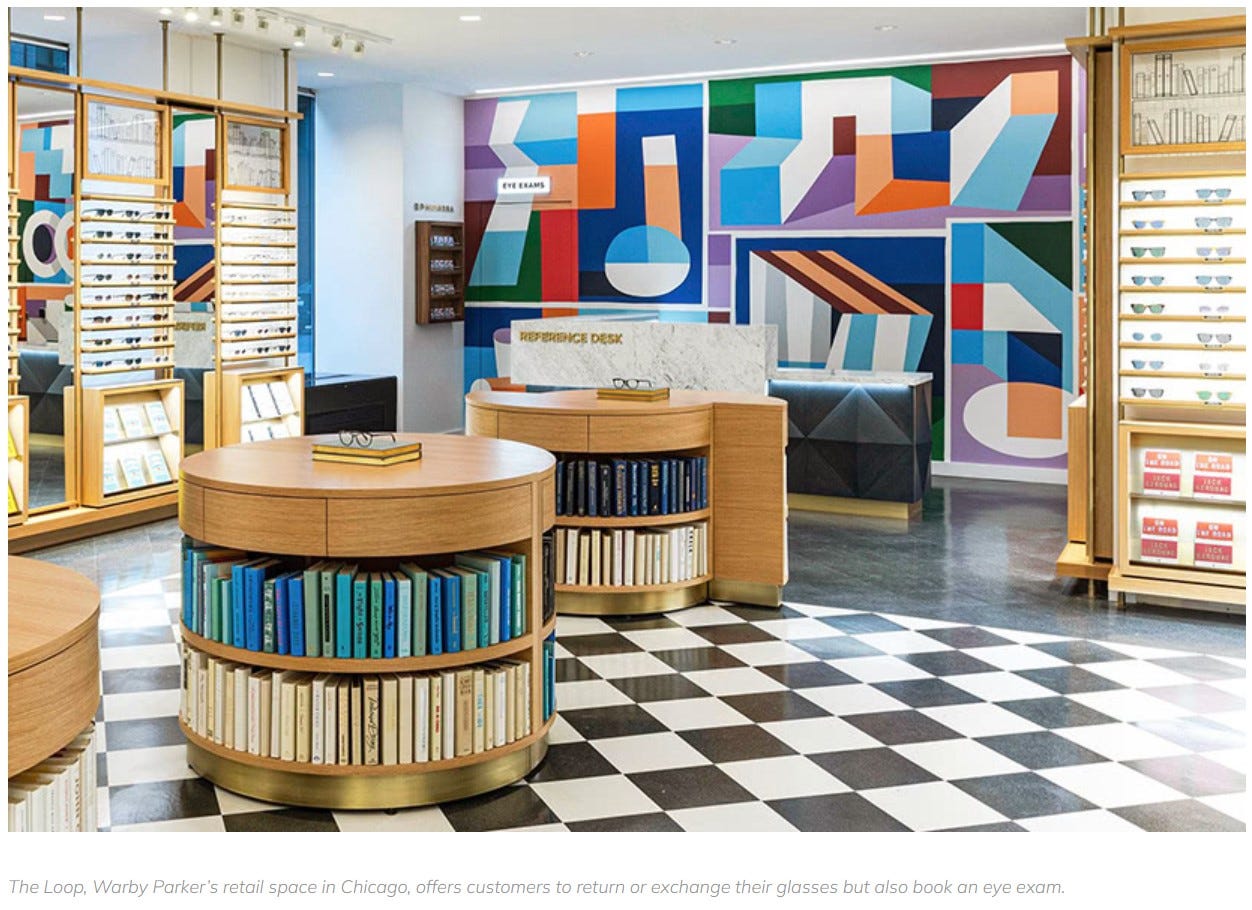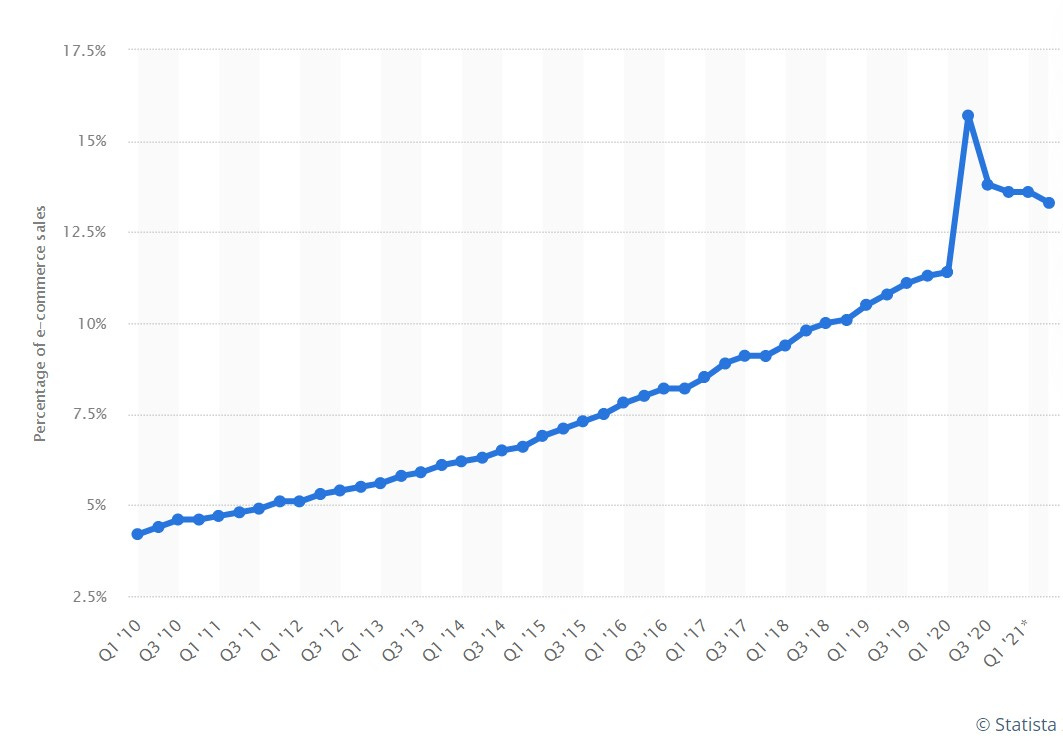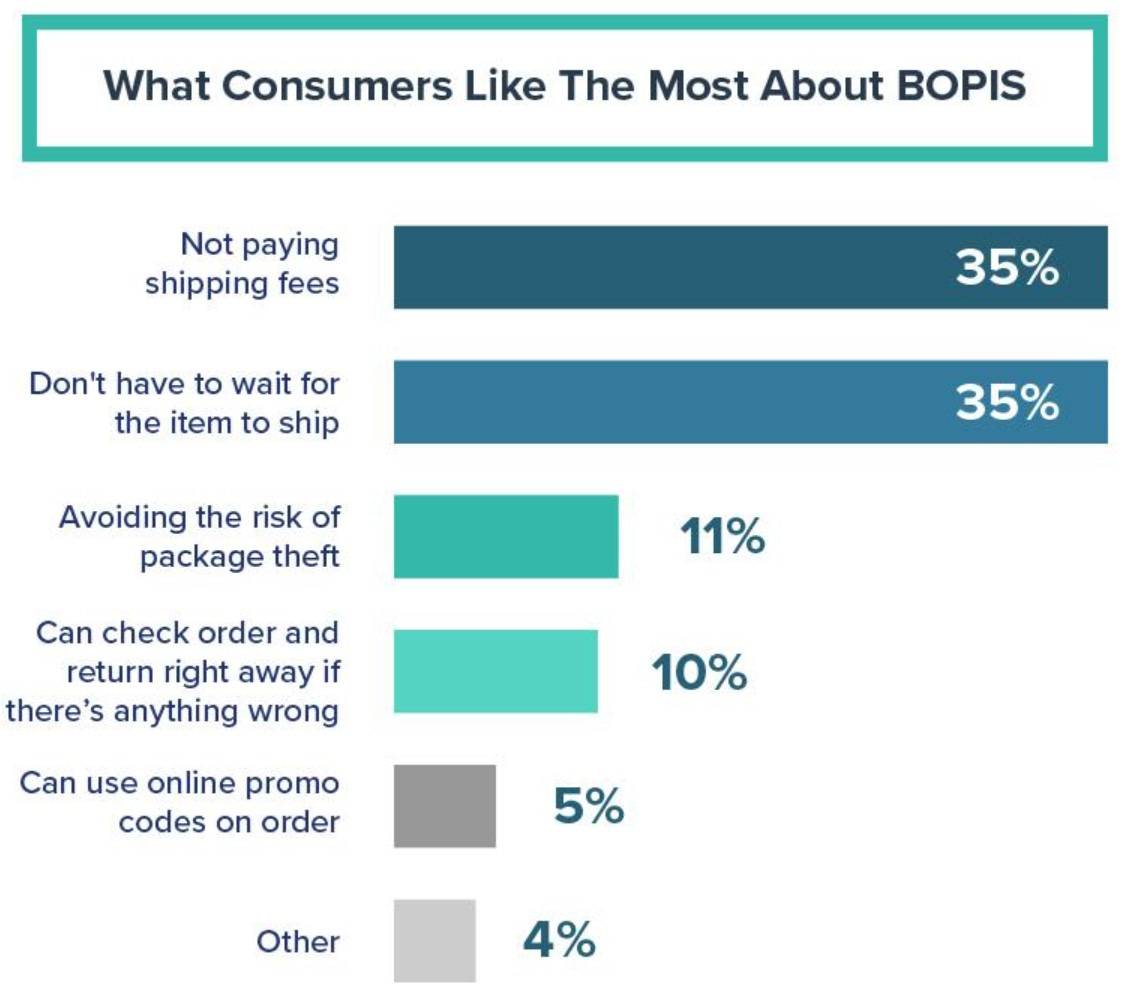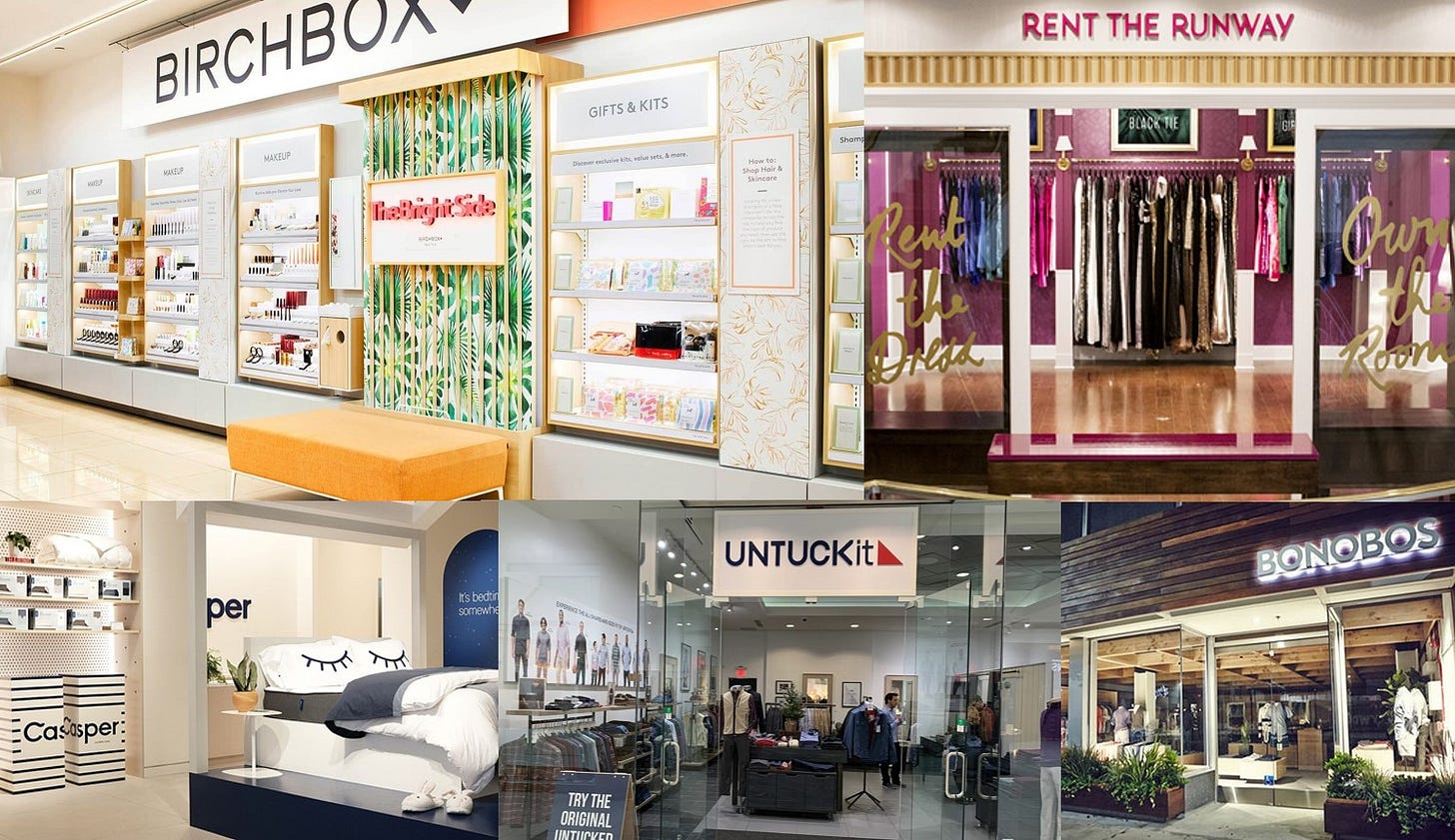Hey DTC Merchants: It's Time to Jump into Physical Retail
The future of retail is all about serving the customer wherever she wants to be served, and that includes physical stores. Here's why!
This week’s edition is free to everyone. No paywall!
Why?
First, to thank all of our free subscribers for continuing to support All Things Retail. The weekly readership, even with limited content access, is superb. I appreciate that.
Second, to show all free subs how the premium content has grown and evolved since we launched the paid version. I hope you agree there are more actionable ideas than ever, along with several new features that can add value to your business.
Third, to encourage you to subscribe to our paid version. At $10/month or $100/year, many merchants have told me it’s a bargain. You need to decide that for yourself, but as some of our marketing states: “Is one good idea a year worth $100?” … well, we will provide many more good ideas that that. So before we move on, please consider subscribing to our Premium Edition here:
DTC Sellers: It's Time to Jump into Physical Retail Stores!
I know. Retail is dead, meaning bricks and mortar retailing will go away sooner rather than later.
Nonsense!
It’s more clear than ever that physical retail is not dying, but in fact it’s an absolutely necessary component of any and every merchant’s go-to-market strategy.
Other than perhaps a few value-focused companies like TJX or Five Below, every physical retailer must have an e-commerce offering. That’s old news.
What has been bubbling up for a few years now is the realization that pure-play digital sellers will need to evolve into physical stores in order to sustain their growth and profitability. It’s a two way street.
You may ask: “Am I sure about this?”
You bet I am!
But don’t rely on my opinion. Take a peek at this from Allbirds (current valuation of about $2.9 billion):
“As our store fleet expands, we expect our growth to accelerate, as compared to 2020,” Allbirds said. “We believe our new stores will also be highly profitable, have attractive payback periods, serve as good capital investments, and be positioned well to take advantage of physical retail’s recovery from the pandemic.”
11% of Allbirds sales come from their physical stores, despite just launching them a few years ago.
Shoppers who visited both a physical location and the Allbirds website spent 1.5-times more money than a customer who only went to a store or shopped online alone.
In the three months after their Boston store’s debut, web traffic in the area rose 15%. The stores are driving traffic to the website!
This is one example of the value of (and in theory the need for) physical stores. But wouldn’t Allbirds be just fine sticking with selling online?
It’s doubtful. Per McKinsey, fewer than 0.5% of Digitally Native Brands have reached $100 million in revenues, and more than 90% earn less than $1 million in annual revenues.
Physical stores are a critical element of driving growth.
One of the pioneers in shifting from an online-only offering to omnichannel, Warby Parker, said it had more than 145 stores as of June 30. The company plans to open 30 to 35 locations this year and aims to expand at that pace annually.
“Our retail stores are highly productive,” the company said in an SEC filing, adding that its average sales per square foot clocks in at a hefty $2,900. “Our stores serve as valuable marketing vehicles for introducing new customers to our brand and driving repeat purchases and, in turn, positively impact our sales retention rate,” Warby Parker said.
Ok, so the question is “why is this the case; why are physical stores so necessary?”
There are several reasons:
e-Commerce Produces Less than 15% of Retail Revenue: consumers are shifting back to physical stores in 2021, and that 15% may skew even more in favor of physical stores. If you ignore bricks & mortar you are in effect ignoring the vast majority of potential customers.
Customers Purchase More When They Can Touch & Try: customers are more likely to buy a product when they see it in person. Per KPMG, the top reason consumers prefer to shop in physical stores is to see, experience and test products in person before buying them.
Impulse Sales Occur More Often in Physical Stores: it’s much easier, through creative merchandising, to add one or more items to the units per transaction in a bricks & mortar store. While this may seem nice but not necessarily material, on an annualized basis this is truly a sales advantage for in-person retailers.
Buy Online & Pick Up In Store is a Winner: BOPIS and curbside pickup have become very popular with consumers and their use continues to increase. Compared to shipping or home delivery, BOPIS is seen by many as a convenience, as it enables customers to get their purchases when they want. For retailers, in-store pickup offers plenty of benefits: it’s cheaper than delivery, it brings shoppers through the doors, and it can lead to bigger baskets. According to Forrester research, 30% to 40% of consumers buy additional items when they get into the store.
In-Person Guest Service: Despite the popularity of online shopping, the human touch is still an important part of the retail experience. According to research for RetailEXPO, almost 64% of shoppers say that knowledgeable and helpful sales associates make them more likely to visit a physical store, and 75% of shoppers are likely to spend more after receiving exceptional service from in-store associates.
Engage with Consumers: watching how customers shop, and chatting with them about their likes and dislikes, is a superpower for bricks & mortar merchants. ModCloth opened its first brick-and-mortar store after 13 years of selling online only. “We discovered small things, the details our customers love," Matt Kaness, president and CEO at ModCloth, told USA Today. "They loved linings in dresses and skirts, and they loved pockets.” Forrester Research adds “From a market research standpoint, a store pays for itself. The amount of market research you gain just by observing people, it’s the equivalent of 100 focus groups”.
Growing Your Brand is Easier in Bricks & Mortar: it can be hard to stand out online, as a consumer is rarely immersed in a brand experience on e-commerce. Conversely, a physical store gives merchants the chance to create a truly engaging brand experience. Experiential elements, showrooms, Instagram-worthy areas and overall concept design can enable retailers to immerse customers in their brand culture, creating lasting impressions.
Physical Stores Bring More Traffic to your Online Store: research from the International Council of Shopping Centers shows that when a retailer opens a new physical store location, traffic to their website increases by 37% the following quarter. In addition, the number of online mentions of the brand and online searches increase dramatically. But there is more! According to a survey from Harvard Business Review, shoppers who buy both online and in physical stores tend to spend more on average compared to those who interact with a business on only one channel.
Return Rates are Lower in Physical Stores: items purchased in physical stores are less likely to be returned than products bought online. The negative impact on net revenues and more importantly profits are dramatically higher for online merchants, especially if they do not have stores to accept returns of online purchases.
Digital Advertising Rates are Rising & ROI is Declining: there are 3 pieces of this pie: costs, effectiveness, and usage. First, cost. Per CNBC, Polly Wong is President of a direct marketing agency working with retailers and DTC brands. Based on her agency’s information, cost per thousand viewers did not increase in January 2021 but crept up in February +6% and jumped in March +68%. In April the cost topped out at +89%. May increased by +69% and June by +42%. Scary!
In terms of effectiveness, look no further than the fallout from Apple’s privacy changes. When Apple made privacy changes in April, it impacted how apps can track users. Per CNBC, many consumers have since opted out of tracking by popular apps, which means businesses are gathering less information on users’ daily habits and interests. As a result, it becomes much more difficult for advertisers to target people on the internet effectively.
Finally, usage. As consumers leave their homes more and more frequently, they are simply scrolling less and less, potentially reducing impressions for online ads.
All of these are reasons to explore physical retailing and in theory, generate a much higher ROI on your ad spend and simply leverage existing shopper traffic.
DTC Shipping & Fulfillment Costs are Rising: leaving aside the impact of current supply chain delays, shipping costs for eCommerce sellers continue to increase. Per Easyship, “Shipping costs spiked in 2020 and continue to climb in 2021. The post-pandemic surge in eCommerce has strained the delivery systems of domestic carriers to capacity. In a world of expedited delivery and frequent returns, UPS and FedEx are raising prices to compensate for their elevated delivery costs.” Shifting into physical retail is one way to partially mitigate these increases and retain a larger percentage of your gross margin dollars.
Stores as Micro-DC’s: logistics costs in DTC retail, as noted above, continue to increase, potentially eroding margins significantly. Many retailers are realizing savings by using some or all of their physical stores as fulfillment centers, to support and strengthen their supply chain. Product deliveries are made faster, pleasing the customer, and this often happens at a lower cost than shipping, pleasing the merchant.
There are plenty of reasons to DTC merchants to explore physical retailing. The next question is how?
Many companies have jumped directly into permanent stores (typically 5-year or longer leases with a full store design & buildout), many with great success. This is a bit riskier and more expensive than a pop-up store test program, but offers the benefit of representing your brand and providing the customer experience exactly as you envision. I have followed this strategy many times in the past and support it, especially if the merchant is well capitalized and able to invest the appropriate dollars.
As an alternative, pop-up (temporary) stores are a lower cost, lower risk means of testing physical retail and even specific markets and sites. While you will be a bit more constrained in terms of creating the ideal brand experience, you certainly can get 70% -80% of the way there. If you want to dig deeper into pop-ups, click here to read Issue #4 of All Things Retail. If you have questions on testing either permanent or pop-up stores as an evolution of your DTC offering, reach out to me. I’ll be happy to chat.
What Do You Think?
We all are experiencing the impact of staffing shortages and supply chain delays. Both are very real and show no signs of abating. I have written about both going back to early July, and I have shared many images of stores with empty shelves, long lines at the checkout, and being in a general state of disarray.
As I continue to visit stores, I am beginning to wonder how many of these salesfloor issues are unavoidable (“no employees”) and how many are indeed addressable with the proper focus. I am forming an opinion that store leadership may be (sometimes but not all the time) swayed by all the negative news into believing they can no longer impact the conditions in their store, when in fact they can.
Why do I say this? Simply because I see potential solutions when visiting these challenged stores.
Target had empty cosmetic fixtures blocking access to other aisles in that department on a busy Saturday;
Old Navy had 8-10 half-dressed female mannequins blocking access to the men’s department, on a pretty quiet Saturday;
Kohl’s had a line to pay that literally snaked all the way to the back of the store.
Yet in every one of these situations, there were plenty of employees doing seemingly less important tasks (sometimes just puttering around straightening shelves). Could / should have management focused on these issues preventing some sales and reassigned tasks? Or have their standards declined so much, in theory because of these holistic industry issues, that they accept the unacceptable?
Sometimes real issues become excuses for poor service, execution etc. I am beginning to believe this is happening right now.
Retail Quickie:
For Jeff Bezos, grit, ambition and energy is more valuable than a specific skill set.
I read this story from a former Amazon employee and it struck me how powerful this hiring thesis is as a means of supporting and growing a business. I wanted to share it with you.
“It took years for me to fully understand why Bezos took a chance on me and gave me that big break. He exclusively surrounded himself with people he had to hold back, not push forward. He created teams of people so ambitious, creative and determined that they made up for any expertise they lacked.
In that kind of environment, Bezos would only have to use his energy as a leader to channel our energy, rather than trying to pull it out of us. I learned that the key to Bezos and Amazon’s early success was this tireless pursuit of the exceptional.”
Retail News You Can Use:
EY Insight on Supply Chain Issues, Near and Long-Term
Retailers Hail Lifting of Travel Ban, Return of International Tourists With Hopes of Sales Rebound
Miniso Expanding its $10 Store Concept
Brick & Mortar Retailers Are Reimagining the In-Person Luxury Experience
What 3 Big Mall Bankruptcies say About the State of Retail
Five Big Predictions for Retail in 2022
The Future of Retail: It’s More About Magic Than the Muscle of Massive Inventory
Leadership Caffeine™—Are You the Cause of Your Team’s Creativity Deficit?
How the Pandemic Changed Retail Design
Four Use Cases For AI Voicebots That Help Improve The Retail Customer Experience
With 30+ years of highly successful retail experience (both physical and online), my firm can guide you in your consideration of and potential entry into physical retail.
Having planned and opened over 1,800 retail locations, our expertise is unequaled. We will help you develop and scale a physical store initiative, using pop-up shops, permanent locations, or both, in an extremely low-cost, risk-averse manner. From strategy to financial modeling, site selection, staffing, merchandising strategies, marketing programs and overall program execution, our expertise will help ensure your project’s success!
Quote of the Week:
"A goal is a dream with a deadline." -Napoleon Hill
"I'd rather regret the things I've done than regret the things I haven't done." -Lucille Ball




